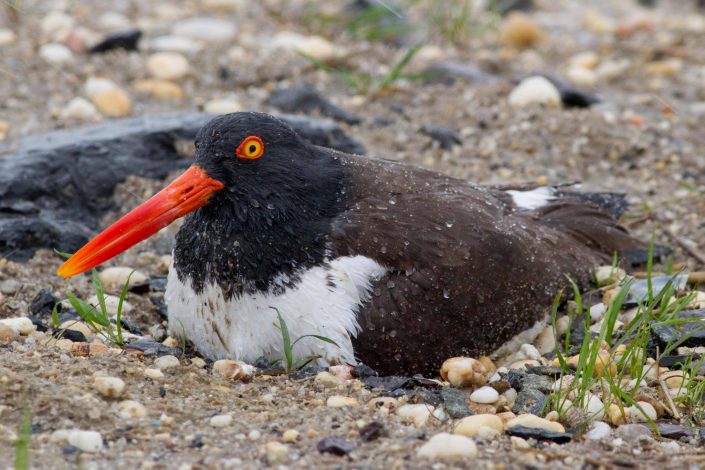Oystercatcher nesting season is underway
By Emily Heiser, Wildlife Biologist
Many piping plover and American oystercatcher pairs have been busy laying their eggs over the last few weeks. As beach nesting bird biologists, we invest a lot of time into every pair at our sites. We revel in their successes and feel defeated at their losses. Unfortunately, many nests did not fare well in the April 25th Nor’easter that was coupled with new moon tides. Luckily, it is early enough in the season that all of them have begun, or will soon begin, attempting new nests.
The breeding habitat of the American oystercatcher in New Jersey consists of coastal beaches, inlet systems, and salt marshes. Population estimates in New Jersey suggest 350-400 breeding pairs can be found here from March through August. Much of the monitoring and research done with American oystercatchers in New Jersey takes place on the coastal beaches where other beach nesting birds, such as piping plovers, least terns and black skimmers, are found. In 2016, more than 120 breeding pairs of beach nesting American oystercatchers successfully fledged 83 chicks. This was an especially productive year for those pairs and productivity levels were well above the target goal of .5 chicks per pair.

Oystercatchers arrive back on their breeding grounds here in New Jersey in early March to set up breeding territories and begin nesting. Once paired up, adults typically lay one to three eggs. Both the male and female will take turns incubating the nest for 28 days. Once chicks hatch, they are semi-precocial, which means they are born in an advanced state, but are still reliant on adults for food and protection. Oystercatcher chicks are fledged (or able to fly) 35 days after hatching. After fledging, most Oystercatchers migrate to the southeast, but a wintering population does remain here in New Jersey.
American oystercatchers are listed as a Species of Special Concern in New Jersey. A “Species of Special Concern” is a status determined by the New Jersey Division of Fish & Wildlife and applies to species that have an inherent threat to their population or have evidence of recent population declines. Since American oystercatchers share the same habitat as other endangered or threatened beach nesting birds (piping plovers, least terns, and black skimmers), they also share the same threats to their nests and young. Human disturbance, a host of predators, and flooding events, such as the one that took place last week, are just some of the many threats beach nesting birds face daily.
The Conserve Wildlife Foundation of New Jersey has long partnered with the New Jersey Division of Fish and Wildlife’s Endangered and Nongame Species program in the monitoring and management of New Jersey’s endangered beach nesting birds. Fencing and signage are placed in nesting areas to alert beachgoers to the presence of nesting American oystercatchers and other beach nesting birds. Throughout the summer, CWFNJ and partners will be out on the beaches monitoring and collecting data that will be used to track population trends and identify threats to oystercatchers and their young.
Emily Heiser is a wildlife biologist for Conserve Wildlife Foundation of New Jersey.
LEARN MORE
Discover more from Conserve Wildlife Foundation of NJ
Subscribe to get the latest posts sent to your email.